Beijing Opera
- 格式:doc
- 大小:92.50 KB
- 文档页数:5
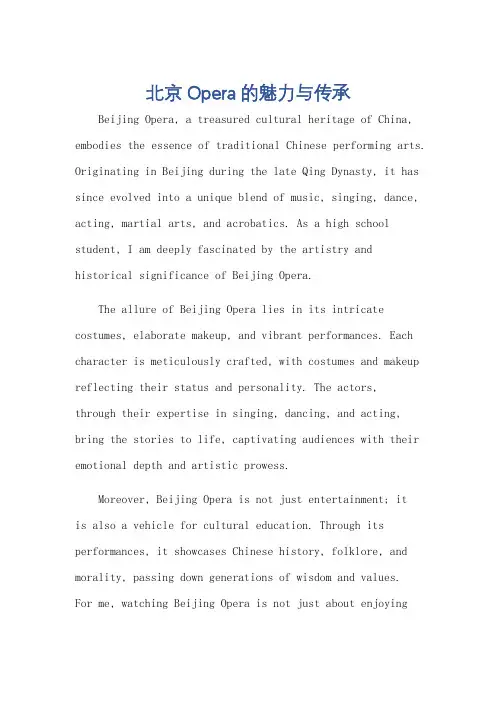
北京Opera的魅力与传承Beijing Opera, a treasured cultural heritage of China, embodies the essence of traditional Chinese performing arts. Originating in Beijing during the late Qing Dynasty, it has since evolved into a unique blend of music, singing, dance, acting, martial arts, and acrobatics. As a high school student, I am deeply fascinated by the artistry andhistorical significance of Beijing Opera.The allure of Beijing Opera lies in its intricate costumes, elaborate makeup, and vibrant performances. Each character is meticulously crafted, with costumes and makeup reflecting their status and personality. The actors,through their expertise in singing, dancing, and acting, bring the stories to life, captivating audiences with their emotional depth and artistic prowess.Moreover, Beijing Opera is not just entertainment; itis also a vehicle for cultural education. Through its performances, it showcases Chinese history, folklore, and morality, passing down generations of wisdom and values.For me, watching Beijing Opera is not just about enjoyingthe show; it is also about learning about Chinese culture and traditions.Unfortunately, with the advent of modern entertainment forms, Beijing Opera faces challenges in attracting younger audiences. However, its unique charm and artistic value remain unchanged. Many organizations and individuals are now working to promote and preserve Beijing Opera, introducing it to new audiences through innovative methods such as educational programs, online streaming, and collaborations with other art forms.As a young student, I believe it is crucial to appreciate and cherish our cultural heritage. I am committed to learning more about Beijing Opera, participating in related activities, and sharing its beauty with my peers. By doing so, I hope to contribute to the preservation and continuation of this remarkable art form. In conclusion, Beijing Opera is not just a performing art; it is a cultural icon that represents the essence of Chinese civilization. Its charm and significance transcend time and space, making it a timeless treasure that deserves our utmost respect and preservation. As a new generation,we have the responsibility to uphold this legacy and passit down to future generations.**北京Opera的魅力与传承**京剧,作为中国的珍贵文化遗产,体现了中国传统表演艺术的精髓。
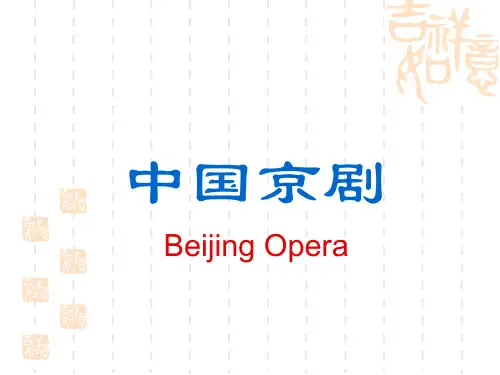
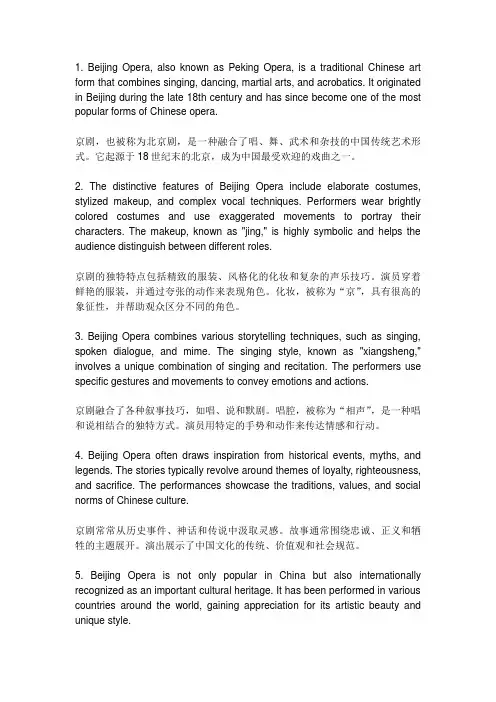
1. Beijing Opera, also known as Peking Opera, is a traditional Chinese art form that combines singing, dancing, martial arts, and acrobatics. It originated in Beijing during the late 18th century and has since become one of the most popular forms of Chinese opera.京剧,也被称为北京剧,是一种融合了唱、舞、武术和杂技的中国传统艺术形式。
它起源于18世纪末的北京,成为中国最受欢迎的戏曲之一。
2. The distinctive features of Beijing Opera include elaborate costumes, stylized makeup, and complex vocal techniques. Performers wear brightly colored costumes and use exaggerated movements to portray their characters. The makeup, known as "jing," is highly symbolic and helps the audience distinguish between different roles.京剧的独特特点包括精致的服装、风格化的化妆和复杂的声乐技巧。
演员穿着鲜艳的服装,并通过夸张的动作来表现角色。
化妆,被称为“京”,具有很高的象征性,并帮助观众区分不同的角色。
3. Beijing Opera combines various storytelling techniques, such as singing, spoken dialogue, and mime. The singing style, known as "xiangsheng," involves a unique combination of singing and recitation. The performers use specific gestures and movements to convey emotions and actions.京剧融合了各种叙事技巧,如唱、说和默剧。
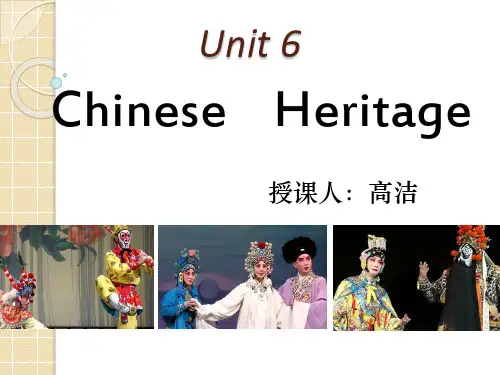
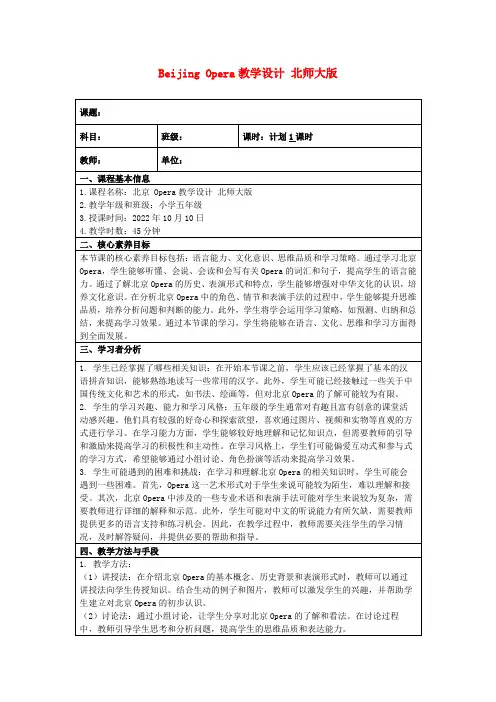
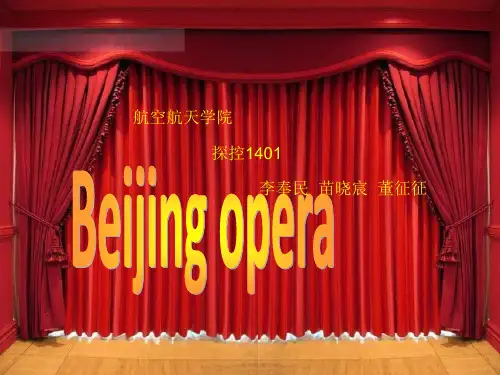
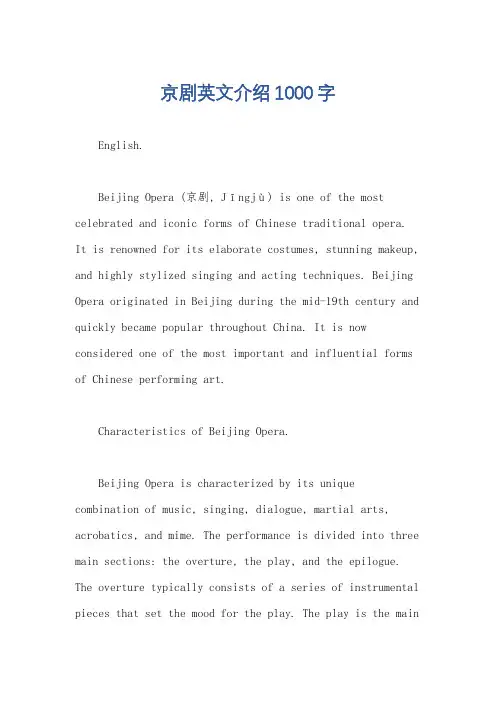
京剧英文介绍1000字English.Beijing Opera (京剧, Jīngjù) is one of the most celebrated and iconic forms of Chinese traditional opera.It is renowned for its elaborate costumes, stunning makeup, and highly stylized singing and acting techniques. Beijing Opera originated in Beijing during the mid-19th century and quickly became popular throughout China. It is now considered one of the most important and influential forms of Chinese performing art.Characteristics of Beijing Opera.Beijing Opera is characterized by its unique combination of music, singing, dialogue, martial arts, acrobatics, and mime. The performance is divided into three main sections: the overture, the play, and the epilogue. The overture typically consists of a series of instrumental pieces that set the mood for the play. The play is the mainpart of the performance and tells a story through a combination of singing, dialogue, and action. The epilogueis a short section that concludes the play and provides a moral or philosophical message.Beijing Opera is also known for its elaborate costumes and makeup. The costumes are often very colorful and adorned with intricate embroidery. The makeup is highly stylized and helps to create the characters' personalities and emotions.Performance Techniques.Beijing Opera actors undergo rigorous training tomaster the specialized performance techniques that are required for this art form. The singing is characterized by a high-pitched, nasal style that is unique to Beijing Opera. The actors also use a variety of hand gestures, body movements, and facial expressions to convey emotions and actions.Roles.Beijing Opera characters are classified into four main types: sheng (male), dan (female), jing (painted face), and chou (clown). Each type of role has its own unique set of conventions and techniques.Themes.Beijing Opera plays often explore themes of history, legend, love, and betrayal. They often draw on stories from Chinese mythology and folklore, as well as historical events.Influence.Beijing Opera has had a profound influence on Chinese culture and society. It has been featured in numerous films, television shows, and stage productions. The art form has also been exported to other countries around the world, where it has been adapted and incorporated into local performing arts traditions.Significance.Beijing Opera is considered a national treasure ofChina and is protected by the government. It is a livingart form that continues to evolve and adapt to modern audiences. Beijing Opera is a testament to the richcultural heritage of China and its enduring artistic traditions.中文回答:京剧,又称京戏,是中国传统戏曲中最著名、最具代表性的形式之一。
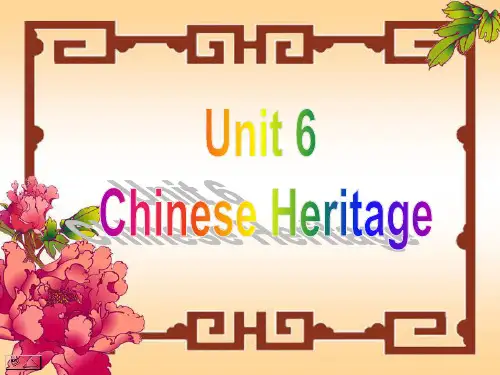
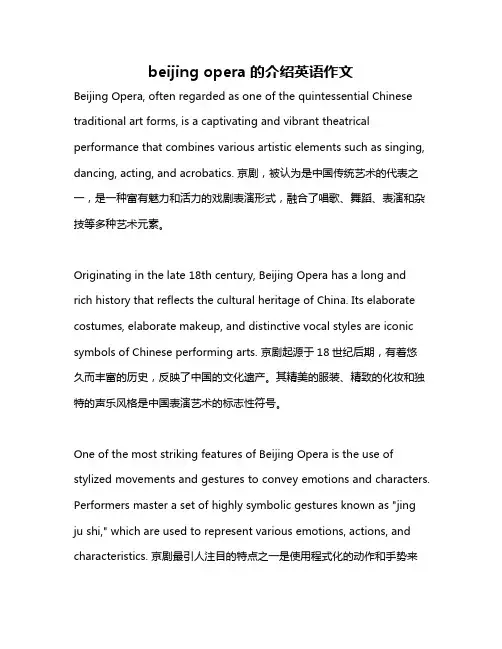
beijing opera的介绍英语作文Beijing Opera, often regarded as one of the quintessential Chinese traditional art forms, is a captivating and vibrant theatrical performance that combines various artistic elements such as singing, dancing, acting, and acrobatics. 京剧,被认为是中国传统艺术的代表之一,是一种富有魅力和活力的戏剧表演形式,融合了唱歌、舞蹈、表演和杂技等多种艺术元素。
Originating in the late 18th century, Beijing Opera has a long and rich history that reflects the cultural heritage of China. Its elaborate costumes, elaborate makeup, and distinctive vocal styles are iconic symbols of Chinese performing arts. 京剧起源于18世纪后期,有着悠久而丰富的历史,反映了中国的文化遗产。
其精美的服装、精致的化妆和独特的声乐风格是中国表演艺术的标志性符号。
One of the most striking features of Beijing Opera is the use of stylized movements and gestures to convey emotions and characters. Performers master a set of highly symbolic gestures known as "jingju shi," which are used to represent various emotions, actions, and characteristics. 京剧最引人注目的特点之一是使用程式化的动作和手势来传达情感和角色。

beijing opera英语作文高中Beijing Opera: A Captivating Fusion of Art, History, and TraditionBeijing Opera, also known as Peking Opera, is a unique and captivating form of traditional Chinese theater that has captivated audiences for centuries. This elaborate and multifaceted art form combines elements of music, dance, acrobatics, and stunning visual displays to create a truly mesmerizing experience. As one of the most well-known and iconic cultural traditions of China, Beijing Opera holds a special place in the hearts of both locals and international audiences alike.At the core of Beijing Opera lies a rich and complex history that dates back to the 18th century. The origins of this art form can be traced to the merging of various regional opera styles, each with its own distinct characteristics and traditions. Over time, Beijing Opera evolved into a highly refined and sophisticated genre, incorporating elements from Kun opera, Hui opera, and other regional performance traditions. This fusion of diverse influences has resulted in a truly unique and captivating art form that continues to captivate audiences around the world.One of the most striking features of Beijing Opera is its intricate and visually stunning costumes and makeup. Performers are adorned in elaborate, brightly colored garments that often feature intricate embroidery and intricate patterns. The use of elaborate headdresses, masks, and face paint is also a hallmark of Beijing Opera, with each character having a distinct and recognizable appearance. This attention to detail is not merely aesthetic but also serves to convey the personality and role of each character within the performance.The music of Beijing Opera is equally captivating, with a unique and complex musical structure that blends traditional Chinese instruments with Western-influenced elements. The orchestra, known as the Jingju, is composed of a variety of traditional Chinese instruments, including the erhu (a two-stringed fiddle), the pipa (a four-stringed lute), and the dizi (a bamboo flute). These instruments, along with percussion and vocal elements, create a rich and powerful soundscape that is both mesmerizing and emotionally evocative.The vocal styles of Beijing Opera are equally distinctive, with performers utilizing a range of techniques that include high-pitched trills, vibrato, and intricate melodic ornamentation. The singing is often accompanied by a unique style of recitation, known as "Xipi" and "Erhuang," which adds an additional layer of complexity and depth to the performance.In addition to the music and visual elements, Beijing Opera is also renowned for its acrobatic and choreographic elements. Performers often engage in intricate and physically demanding movements, including leaps, tumbles, and high-flying stunts. These acrobatic feats are seamlessly integrated into the storytelling, adding an additional layer of excitement and drama to the performance.The stories and narratives of Beijing Opera are equally captivating, drawing from a rich tapestry of Chinese history, mythology, and folklore. These stories often explore themes of love, loyalty, and heroism, with complex and multi-layered characters that capture the imagination of the audience. From the tragic love story of the Butterfly Lovers to the epic tale of the Monkey King, Beijing Opera's repertoire is a testament to the depth and richness of Chinese cultural heritage.Despite the enduring popularity of Beijing Opera, the art form has faced numerous challenges in recent decades. The rise of modern entertainment and the changing cultural landscape have led to a decline in the popularity of traditional theater, with younger generations often finding it difficult to connect with the complex and highly specialized nature of Beijing Opera. However, there are ongoing efforts to preserve and revitalize this art form, with organizations and institutions working to promote its appreciation and understanding both within China and on the global stage.In conclusion, Beijing Opera is a truly remarkable and captivating art form that embodies the rich cultural heritage of China. From its intricate costumes and stunning visual displays to its complex musical structure and captivating storytelling, Beijing Opera is a testament to the enduring power of tradition and the human spirit. Whether you are a seasoned aficionado or a newcomer to this art form, the experience of witnessing a Beijing Opera performance is one that will leave a lasting impression on your heart and mind.。
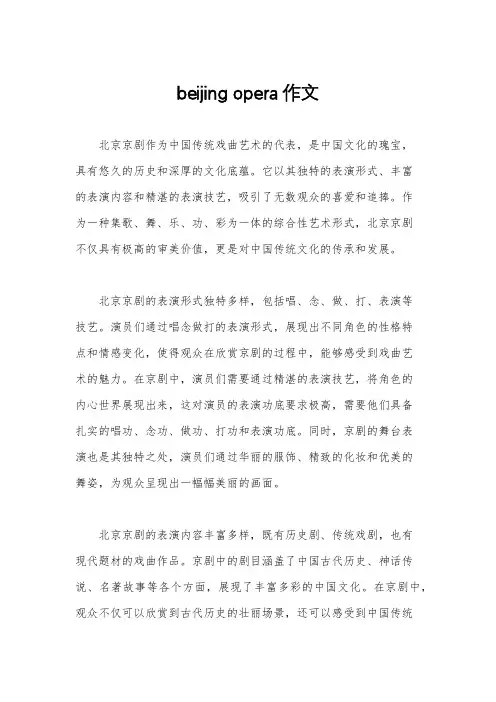
beijing opera作文北京京剧作为中国传统戏曲艺术的代表,是中国文化的瑰宝,具有悠久的历史和深厚的文化底蕴。
它以其独特的表演形式、丰富的表演内容和精湛的表演技艺,吸引了无数观众的喜爱和追捧。
作为一种集歌、舞、乐、功、彩为一体的综合性艺术形式,北京京剧不仅具有极高的审美价值,更是对中国传统文化的传承和发展。
北京京剧的表演形式独特多样,包括唱、念、做、打、表演等技艺。
演员们通过唱念做打的表演形式,展现出不同角色的性格特点和情感变化,使得观众在欣赏京剧的过程中,能够感受到戏曲艺术的魅力。
在京剧中,演员们需要通过精湛的表演技艺,将角色的内心世界展现出来,这对演员的表演功底要求极高,需要他们具备扎实的唱功、念功、做功、打功和表演功底。
同时,京剧的舞台表演也是其独特之处,演员们通过华丽的服饰、精致的化妆和优美的舞姿,为观众呈现出一幅幅美丽的画面。
北京京剧的表演内容丰富多样,既有历史剧、传统戏剧,也有现代题材的戏曲作品。
京剧中的剧目涵盖了中国古代历史、神话传说、名著故事等各个方面,展现了丰富多彩的中国文化。
在京剧中,观众不仅可以欣赏到古代历史的壮丽场景,还可以感受到中国传统文化的博大精深。
同时,京剧还不断吸收现代题材,通过现代化的表现手法,使得京剧更加贴近当代观众,增加了京剧的时代感和生活气息。
北京京剧的表演技艺精湛,演员们需要通过长期的训练和磨练,才能够掌握京剧的表演技艺。
尤其是京剧的唱功和念功,需要演员们具备极高的音乐修养和声乐技巧,才能够胜任。
此外,京剧的打功和表演功底也是演员们需要不断提高和完善的方面,需要他们具备出色的身体素质和舞台表演能力。
因此,京剧演员们需要通过不断的练习和钻研,才能够在舞台上展现出精湛的表演技艺。
北京京剧作为中国传统戏曲艺术的代表,不仅具有悠久的历史和深厚的文化底蕴,更是中国传统文化的重要组成部分。
京剧通过其独特的表演形式、丰富的表演内容和精湛的表演技艺,吸引了无数观众的喜爱和追捧。
评价beijing opera英语作文Beijing Opera, also known as Peking opera, is one of the most famous traditional Chinese performing arts forms. With its unique blend of music, dance, acrobatics, and acting, Beijing Opera has captivated audiences both in China and around the world for centuries. In this essay, we will delve into the beauty and significance of Beijing Opera, examining its history, characteristics, and cultural impact.Originating in the late 18th century during the Qing Dynasty, Beijing Opera has a rich history that dates back over 200 years. It was developed in Beijing as a combination of various regional opera traditions, including Kunqu, Yiyang, Hanju, and Luantan. Over time, Beijing Opera evolved into a distinct art form with its own unique style and characteristics.One of the defining features of Beijing Opera is its elaborate costumes and makeup. Performers wear colorful, intricately designed costumes that represent different characters and roles in the opera. The makeup, known as "jing," is equally elaborate, with each color and pattern symbolizing specific character traits and emotions. For example, red makeup symbolizes bravery and loyalty, while white makeup represents treachery and villainy.Another hallmark of Beijing Opera is its distinctive singing style, known as "jingju." Performers use a combination ofsing-song dialogue, recitative, and vocal embellishments to convey the emotions and motivations of their characters. The music, which is accompanied by traditional Chinese instruments such as the erhu, pipa, and gong, adds depth and atmosphere to the performances.In addition to singing, Beijing Opera also incorporates elements of dance and acrobatics. Performers execute intricate dance movements and acrobatic feats to enhance the storytelling and create a visually captivating performance. These physical skills require years of training and discipline, making Beijing Opera one of the most demanding and respected art forms in China.The stories presented in Beijing Opera are often drawn from Chinese history, literature, and mythology. They typically revolve around themes of loyalty, honor, and righteousness, with characters facing moral dilemmas and epic challenges. Through its storytelling, Beijing Opera not only entertains audiences but also imparts moral lessons and cultural values.Beijing Opera has had a profound impact on Chinese culture and society. It has played a significant role in preservingtraditional Chinese art forms and promoting national identity. The art form has also influenced other forms of Chinese performing arts, such as martial arts, dance, and music.In recent years, Beijing Opera has gained international recognition and popularity. It has been performed in venues around the world, exposing audiences to the beauty and complexity of Chinese culture. With its timeless stories and vibrant performances, Beijing Opera continues to enchant and inspire people of all ages and backgrounds.In conclusion, Beijing Opera is a treasure of Chinese cultural heritage that deserves appreciation and recognition. Its unique blend of music, dance, acrobatics, and acting creates a mesmerizing spectacle that captivates audiences and transcends language and cultural barriers. As we celebrate the beauty and significance of Beijing Opera, we honor the rich tradition and artistry of this ancient art form.。
京剧(Beijing Opera/ Peking Opera)是中国的国粹。
作为一门古老的艺术,京剧的服装(costume)、脸谱(facial mask)更易被人喜爱。
不同的服装类型反映不同的人物身份特征。
富贵者的服装缀满精美的刺绣;穷困者的服装则简单朴素,少有装饰(elemental)。
脸谱是京剧中塑造人物形象的重要手段,它是用不同的颜色在脸上勾画出来的。
脸谱的颜色让人一看便知角色(portray)的善恶。
比如白色代表奸诈(treachery),黑色代表正直不阿,黄色是骁勇,蓝、绿色多用于绿林好汉(rebellious fighters),金、银色多用于神佛(divinity and Buddhism)等。
参考译文Beijing Opera is the cream of the Chinese culture. As a traditional art form, its costumes and facial mask are more popular with people. Different styles of costumes are used to reflect the status of different characters. There are more decorations in the costumes of nobles,while those of the poor tend to be simple and less elemental. Facial masks can reflect qualities of different characters. Facial masks using different colors are important ways to portray a character. People can tell a hero from a villain by the colors of the masks. In general,white usually represents treachery, black represents righteousness, yellow represents bravery, blue and green represent rebellious fighters,while gold and silver represent divinity and Buddhism.1。
向外国朋友介绍京剧的英语作文Beijing Opera, also known as Peking Opera, is a traditional Chinese art form that has been passed down for centuries. 京剧,又称北京opera,是一种传统的中国艺术形式,已流传了几个世纪。
It is characterized by its unique combination of singing, acting, martial arts, and acrobatics. 它以独特的歌唱、表演、武术和杂技的组合而闻名。
The performers wear elaborate costumes and makeup, and the performances often include colorful props and intricate choreography. 演员身着精美的服装和化妆,表演中经常包含丰富多彩的道具和复杂的编舞。
Beijing Opera is not only a form of entertainment, but also a reflection of Chinese culture and history. 京剧不仅是一种娱乐形式,也是对中国文化和历史的反映。
One of the key elements of Beijing Opera is the use of distinct vocal styles. 京剧的一个关键元素是独特的声乐风格。
The performers use a combination of singing, chanting, and recitative to convey the emotions of the characters. 演员使用歌唱、吟诵和唱词结合的方式来传达角色的情感。
英语作文京剧带翻译Beijing Opera。
Beijing Opera, also known as Peking Opera, is one of the most renowned traditional Chinese art forms. It combines music, vocal performance, mime, dance, and acrobatics to create a unique and captivating theatrical experience. With its elaborate costumes, intricate makeup, and dramatic storytelling, Beijing Opera has captivated audiences for centuries and continues to be a beloved cultural treasure in China.京剧,又称为北京戏,是中国最著名的传统艺术形式之一。
它结合了音乐、声乐表演、默剧、舞蹈和杂技,创造出独特而引人入胜的戏剧体验。
凭借其精美的服装、精致的化妆和戏剧性的叙事,京剧几个世纪以来一直吸引着观众,并且在中国仍然是一项备受喜爱的文化宝藏。
The origins of Beijing Opera can be traced back to the late 18th century, during the Qing Dynasty. It wasinitially developed as a form of entertainment for the imperial court, combining elements of various regional opera styles from around China. Over time, Beijing Opera evolved into a distinct art form with its own unique characteristics and performance techniques.京剧的起源可以追溯到18世纪晚期,清朝时期。
英语作文京剧带翻译Beijing Opera。
Beijing Opera, also known as Peking Opera, is a traditional Chinese performing art that combines music, vocal performance, mime, dance, and acrobatics. It originated in the late 18th century and was fully developed in the 19th century in Beijing.京剧。
京剧,又称为北京京剧,是一种传统的中国表演艺术,它结合了音乐、声乐表演、默剧、舞蹈和杂技。
它起源于18世纪末,并在19世纪在北京得到充分发展。
The art form is characterized by its unique singing style, elaborate makeup, colorful costumes, and acrobatic fighting techniques. The performers use a combination of singing, speaking, acting, and dancing to tell stories from Chinese history, folklore, and literature.这种艺术形式的特点是其独特的唱腔风格,精致的化妆,丰富多彩的服饰和杂技格斗技巧。
表演者利用唱、念、做、打的结合方式来讲述中国历史、民间传说和文学故事。
The performance of Beijing Opera is a feast for theeyes and ears. The actors' movements are precise and graceful, and the singing is powerful and emotive. The combination of music, singing, and acrobatics creates a mesmerizing and unforgettable experience for the audience.京剧的表演是一场视觉和听觉的盛宴。
京剧(Beijing Opera)又称平剧、京戏,是中国影响最大的戏曲剧种,分布地以北京为中心,遍及全国。
清代乾隆五十五年起,原在南方演出的三庆、四喜、春台、和春四大徽班陆续进入北京,他们与来自湖北的汉调艺人合作,同时接受了昆曲、秦腔的部分剧目、曲调和表演方法,又吸收了一些地方民间曲调,通过不断的交流、融合,最终形成京剧。
京剧流播全国,影响甚广,有“国剧”之称。
它走遍世界各地,成为介绍、传播中国传统文化的重要手段。
京剧是在北京形成的戏曲剧种之最,至今已有200年的历史。
它是在徽戏和汉戏的基础上,吸收了昆曲、秦腔等一些戏曲剧的优点和特长逐渐演变而形成的。
公元1790年(清乾隆55年),徽戏开始进京。
最早进京的徽戏班是享有盛名的安徽“三庆班”,随后又有“四喜”、“和春”、“春台”诸班,史称“四大徽班”(四大徽班从扬州进京)。
四大徽班和以后陆续进京的徽班,以其优美动听的唱腔和卓越的表演受到观众的欢迎。
[1]现在它仍是具有世界级影响的大剧种。
它的行当全面、表演成熟、气势宏美,是近代中国汉族戏曲的代表。
[2]京剧起源于四个地方的剧种:一是原来流行于安徽省一带的徽剧;二是流行于湖北的汉剧;三是流行于江苏一带的昆曲;四是流行于陕西的秦腔,又叫梆子。
清乾隆末期、嘉庆初期四大徽班进北京后,于嘉庆、道光年间同来自湖北的汉调艺人合作,互相影响,逐渐接受了昆曲、秦腔的部分剧目、曲调和表演方法,并吸收了一些民间曲调、北京土语,逐渐融合发展。
[3]唱指歌唱,念指具有音乐性的念白,二者相辅相成,构成歌舞化的京剧表演艺术两大要素之一的“歌”,做指舞蹈化的形体动作,打指武打和翻跌的技艺,二者相互结合,构成歌舞化的京剧表演艺术两大要素之一的“舞”。
唱、念、做、打京剧表演的四种艺术手法,也是京剧表演四项基本功。
戏曲演员从小就要从这四个方面进行训练,虽然有的演员擅长唱功(唱功老生),有的行当以做功(花旦)为主,有的以武打为主(武净)。
Mei Lanfang Introduction of Peking (Beijing)OperaP eking opera of China is a national treasure witha history of 200 years. In the 55th year of the reign of Emperor Qianlong of the Qing Dynasty(1790) ,the four big Huiban opera Troupes entered the capital and combined with Kunqu opera, Yiyang opera, Hanju opera and Luantan in Beijing's thearetical circle of the time. Through a period of more than half a century of combination and integration of various kinds of opera there evolved the present Peking opera, the biggest kind of opera in China, whose richness of repertoire, great number of artists of performance and of audiences, and profound influence are incomparable in China.Peking opera is a synthesis of stylized action, singing, dialogue and mime, acrobatic fighting and dancing to represent a story or depict different characters and their feelings of gladness, anger, sorrow, happiness, surprise, fear and sadness. In Peking opera there are four main types of roles: sheng (male) dan (young female), jing( painted face,male), and chou (clown, male or female). The characters may be loyal or treacherous, beautiful or ugly, good or bad, their images being vividly manifested.The repertoire of Peking opera is mainly engaged in fairy tales of preceding dynasties, important historical events, emperors, ministers and generals, geniuses and great beauties, from the ancient times to Yao, Shun, Yu, the Spring and Autumn Period, the Warring States Period and the dynasties of Qin, Han, Sui, Tang, Song, Yuan, Ming, Qing. The music of Peking opera is that of the "plate and cavity style".Its melody with harmonious rhythms is graceful and pleasing to the ears. The melody may be classified into two groups: "Xipi" and "erhong", guiding pattern, original pattern, slow pattern, quick pattern, desultary pattern being their chief patterns. The performance is accompanied by a tuneplayed on wind instruments, percussion instruments and stringed instruments, the chief musical instruments being jinghu (a two-stringed bowed instrument with a high register), yueqin( afour-stringed plucked instrument with afull-moon-shaped sound box), Sanxian( athree-stringed plucked instrument), suona horn, flute drum, big-gong, cymbals, small-gong, etc. The costumes in Peking opera are graceful, magnificent, elegant and brilliant, most of which are made in handicraft embroidery. As the traditional Chinese pattern are adopted, the costumes are of a high aesthetic value.The types of facial make-ups in Peking opera are rich and various, depicting different characters and remarkable images, therefore they are highly appreciated. Moreover there are numerous fixed editions of facial make-up.Since Mei Lanfang, the grand master of Peking opera, visited Japan in 1919, Peking opera has become more and more popular with people all over the world, and it has made an excellent contribution to cultural exchange between China and the West, to friendly association and to improvement of solidarity. Peking Opera house of Beijing has been invited to perform in U.S.A., England, France, Germany, Italy (three times), Australia, Japan( four times), Brazil, Turkey, Singapore, South korea and Hongkong (five times). The performances have made an outstanding contribution to Sino-foreign cultural exchange and to the promotion of friendly association of peoples in the world, and were highly appreciated by foreign audiences.In 1993 Peking Opera House of Beijing as a big Peking opera troupe made a performance visit to Taiwan, pushing the cultural exchange to a new height. Peking Opera house of Beijing is willing to participate in activities of international cultural exchange and of commercial performances and sincerely hopes that friends in various countries will make contacts with us about cultural exchange and performances.Address of Peking Opera House: Haihu West lane No.30, Fengtai District, Beijing, China.Post:100077Tel: (008610) 67227775Fax: (008610) 67541215E-mail:huangye@Return to Opera pageWhat Do the Facial Makeups Stand for in Beijing Opera?The art of facial makeups in Chinese operas boasts a long history. In ancient China, there was a form of dance called nuo which was performed at ritual ceremonies to frighten off the ghosts and evil souls and to relieve people of epidemics. Masks were used by performers when they danced. In some areas the nuo ritual ceremonies were later transformed into theatrical performances. Another example of using masks was that of Prince Lanling of the Northern Qi Period (550-577 A. D. ) . It is said that Prince Lanling excelled in martial arts but was too handsome to terrorize the enemy. So he al ways wore a ferocious-looking mask in battles in order to overwhelm the enemy. This story was later brought onto the stage in the Southern and Northern Dynasties as well as in the Sui and Tang dynasties (420-907 A. D. ) . The masks used by the performers at the ritual ceremonies and in the performing art undoubtedly had a bearing on the origination of the facial makeups. In the Tang Dynasty(618-907 A.D. ) , masks continued to be applied in low comedy, and at the same time artists started to dye their faces in portrayal of super-human beings. In the Ming Dynasty(1318-1644 A.D.) , division of roles among actors became more classified on the basis of the Yuan Dynasty (1271- 1368 A.D.) operas and the facial makeups were gradually standardized. In the Qing Dynasty(1644-1911 A.D. ) , with the springing up of Beijing Opera, the art of facial makeups was increasingly perfected. And toward the end of the Qing Dynasty, the facial makeups for different categories of characters became finalized.Facial makeups are a special art in Chinese operas which distinctly show the appearances of different roles as well as their dispositions and moral qualities by means of artistic exaggeration combined with truthful portrayal and symbolism. Facial makeups also serve to express praise or condemnation toward the characters.In some local operas, facial makeups are applied to all the different roles while in Beijing Opera, the mostrepresentative of Chinese operas, facial makeups are limited only to the roles of jing and chou. A chou ischaracterized by his white-painted nose which gives a comic effect and there are relatively few facial makeuppatterns for a chou role. There are a large variety of facial makeup patterns for jing in Beijing Opera, namely,"whole face", "three-tile face", "quartered face", "six-division face", "tiny-flowered face" , "lopsided face" , etc.Different colours such as red, yellow, blue, white, black, purple, green, gold and silver are used for facial makeups. The main colour in a facial makeup symbolizes the disposition of the character. Red indicates devotion, courage and uprightness. Yellow signifies fierceness, ambition and cool-headedness. Blue represents staunchness, fierceness and astuteness. White suggests sinisterness, treacherousness, suspiciousness and craftiness. Black symbolizes roughness and fierceness. Purple stands for uprightness, sophistication and cool-headedness. Gold and silver colours are usually used for gods and spirits.Facial makeups are not only a special art in Chinese operas, but also an art of ornamental design, and have become a new variety in Chinese painting.Beijing opera and Face PatternChinese traditional opera is a comprehensiveperforming art, which combines singing, music, dialogue, acrobatics, martial arts and pantomime. It represents the culmination and distillation of two thousand years of Chinese civilization. During the late Qing Dynasty, a new type of traditionaldrama-Beijing Opera-came into being. In 1790, some troupes of Anhui Opera went to the imperial Palace in Beijing to offer birthday congratulations to the emperor and other members of the royal family. They remained in Beijing and performed for the ordinary citizens.Because of the efforts to learn artistic techniques from other local operas and to the taste of the Based on Anhui Opera, Beijing Opera took shape as an independent opera form between 1840 and 1860. Having incorporated the merits of many other local dramas, Beijing Opera not only appeals to Chinese audiences but also is warmly received by people all over the world.Beijing Opera is a comprehensive performing art that combines music, singing, dialogue, pantomime, acrobatics and martial arts. Symbolism prevails in Beijing Opera. Footwork, gestures, and various kinds of body movements can portray and symbolize the actions of opening a door, climbing a hill, going upstairs, or rowing a boat. Typical Chinese musical instruments are used in a Beijing Opera orchestra. The two-stringed fiddles jing hu and er hu are two of the main instruments. Other instruments include sheng (reed pipes), Yue Qin (moon shaped mandolin), pi pa (the Chinese lute), sue na(the Chinese clarinet), drums, bells, gongs, and hardwood castanets.The character roles in Beijing Opera are divided into four main types according to the sex, age, social status, and profession of the character. Shen refers to male roles. Dan refers to female roles. Jingo refers to the roles with painted faces. Chou, or clown, is a comic character and can be recognized at first sight for his special make-up (a patch of white paint on his nose). The costumes in Beijing Opera impress the audience with their bright colors and magnificent embroidery Face PatternsWhen you are watching a Beijing Opera, the most impressive place to you maybe is the "painted face". Face patterns follow a set mode in composition, sketching and coloring.Face patterns date far back in history. Ancient Chinese entertainers sometimes wore masks known as "dummy faces". In time, following the development of the opera and the needs of the performances, the mask was replaced by the painted patterns. As soon as an actor steps onto the stage, his painted face gives a clear concept of his character--loyal or traitorous, good or evil. The audiences have long accepted such means of expression. In general, red stands for loyalty and uprightness; purple, courage and resolution; black, toughness and irascibility; yellow, brutality andschemtry; white, treachery and machination; gold and silver, mythical figures. The dominant color and the minutely executed patternshighlight the character without imparting a sense of confusion.There are mainly four different kinds of roles, namely sheng, dan, jing, and chou . There used to be another role called mo , which has merged into sheng.Sheng is the male role in Beijing Opera. Sheng, according to the age, personality and status of thecharacters, is subdivided into laosheng, xiaosheng, wensheng and wusheng. Laosheng, also known asxusheng, is a bearded middle-aged or old man who is in most cases a positive character. Xiaosheng isa handsome young man, who can either be a scholar or a military general.Those who specialize in singing and reciting are termed wensheng, whilethose who are skilled in stage-fighting, are called wusheng.Dan is a general term in Beijing Opera for all female roles. In the feudal society of old China, as men andwomen were forbidden to perform on the same stage, all the female roles were played by men. Today,however, there are very few female impersonators. According to the age, status, personality of the characterand the style in acting, dan is further divided into zhengdan , huadan , caidan , wudan and laodan . Zhengdanis also called qingyi because she always wears a qingyi (black costume) . Zhengdan is the type representing the gentle and virtuous young and middle-aged woman. In this type of roles much stress is given in singing. Huadan is the role for a maiden or a young woman, who is either vivacious or shrewdish in character. Emphasis is placed on acting and recitation in this type. Caidan, also called choudan, is the role for a woman of comical or crafty character. A caidan uses heavy make-up of rouge with a patch of white powder covering her nose while her acting is basically the same as that of a chou (clown) . Wudan is the role for a woman of the military type who excels in riding and archery as well as in martial arts. Like wusheng, a wudan does a lot of stage-fighting. Laodan is the role for an old woman. In singing laodan uses the natural voice which is similar to laosheng. In both singing and acting the performer must try to indicate the special characteristics of an old woman.Jing is also known as hualian, a role with a painted face, who is a man of special character, features andpersonality. Jing is further divided into wenjing (civilian type) and wujing (warrior type) . Wenjing must layparticular emphasis on singing and wujing on acrobatic fighting. The face of a jing role is painted with a varietyof coloured patterns which are not only an artistic exaggeration but also an indication of the personality of thecharacter.Chou (clown) is also called xiaohualian , or sanhualian . A chou may be akind-hearted, humorous and funny fellow. However, he may also be very wicked or treacherous .Chou is also divided into wenchou ( civilian type ) , and wuchou ( a clown with martial arts ) . A femalechou is normally called caidan or choudan. A chou always paints his nose powder-white and wears anupturned moustache so as to give a comic effect.。